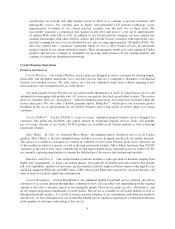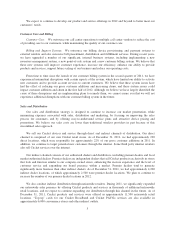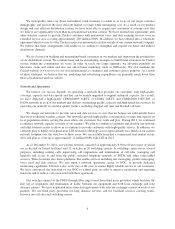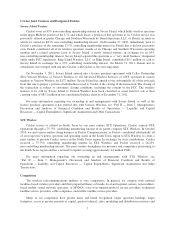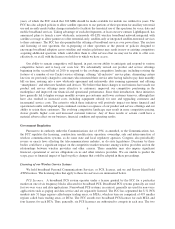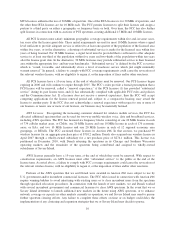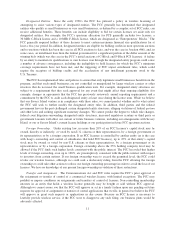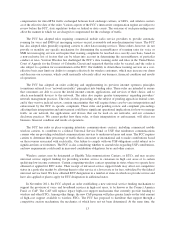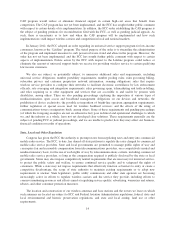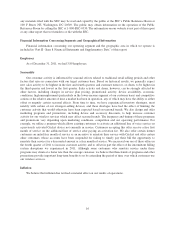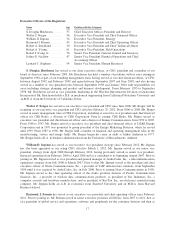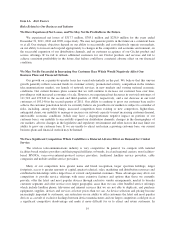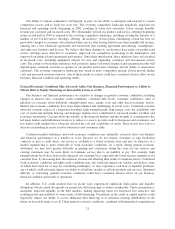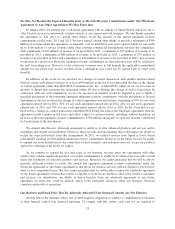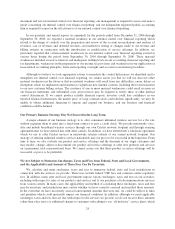Cricket Wireless 2011 Annual Report Download - page 24
Download and view the complete annual report
Please find page 24 of the 2011 Cricket Wireless annual report below. You can navigate through the pages in the report by either clicking on the pages listed below, or by using the keyword search tool below to find specific information within the annual report.CAF program would reduce or eliminate financial support in certain high-cost areas that benefit from
competition. The CAF program has not yet been implemented, and the FCC has sought further public comment
with respect to certain details of its implementation. In addition, the FCC order establishing the CAF program is
the subject of pending petitions for reconsideration filed with the FCC, as well as pending judicial appeals. As
such, there is uncertainty as to how and when the CAF program will be implemented and how such
implementation could impact wireless carriers and competition in local and national markets.
In January 2012, the FCC adopted an order regarding its universal service support program for low-income
consumers, known as the “Lifeline” program. The stated purpose of the order is to streamline the administration
of the program and implement measures to curb perceived waste, fraud and abuse in the program. However, the
order has not yet been implemented, and the FCC has sought further public comment with respect to certain
aspects of implementation. Future action by the FCC with respect to the Lifeline program could reduce or
eliminate the amount of universal support funds we receive for providing wireless service to certain qualifying
low income customers.
We also are subject, or potentially subject, to numerous additional rules and requirements, including
universal service obligations; number portability requirements; number pooling rules; rules governing billing,
subscriber privacy and customer proprietary network information; roaming obligations; rules that require
wireless service providers to configure their networks to facilitate electronic surveillance by law enforcement
officials; rate averaging and integration requirements; rules governing spam, telemarketing and truth-in-billing;
and rules requiring us to offer equipment and services that are accessible to and usable by persons with
disabilities, among others. There are also pending proceedings exploring the imposition of various types of
nondiscrimination, open access and broadband management obligations on our devices and networks; the
prohibition of device exclusivity; the possible re-imposition of bright-line spectrum aggregation requirements;
further regulation of special access used for wireless backhaul services; and the effects of the siting of
communications towers on migratory birds, among others. Some of these requirements and pending proceedings
(of which the foregoing examples are not an exhaustive list) pose technical and operational challenges to which
we, and the industry as a whole, have not yet developed clear solutions. These requirements generally are the
subject of pending FCC or judicial proceedings, and we are unable to predict how they may affect our business,
financial condition or results of operations.
State, Local and Other Regulation
Congress has given the FCC the authority to preempt states from regulating rates and entry into commercial
mobile radio service. The FCC, to date, has denied all state petitions to regulate the rates charged by commercial
mobile radio service providers. State and local governments are permitted to manage public rights of way and
can require fair and reasonable compensation from telecommunications providers, on a competitively neutral and
nondiscriminatory basis, for the use of such rights of way by telecommunications carriers, including commercial
mobile radio service providers, so long as the compensation required is publicly disclosed by the state or local
government. States may also impose competitively neutral requirements that are necessary for universal service,
to protect the public safety and welfare, to ensure continued service quality and to safeguard the rights of
consumers. While a state may not impose requirements that effectively function as barriers to entry or create a
competitive disadvantage, the scope of state authority to maintain existing requirements or to adopt new
requirements is unclear. State legislators, public utility commissions and other state agencies are becoming
increasingly active in efforts to regulate wireless carriers and the service they provide, including efforts to
conserve numbering resources and efforts aimed at regulating service quality, advertising, warranties and returns,
rebates, and other consumer protection measures.
The location and construction of our wireless antennas and base stations and the towers we lease on which
such antennas are located are subject to FCC and Federal Aviation Administration regulations, federal, state and
local environmental and historic preservation regulations, and state and local zoning, land use or other
requirements.
14


